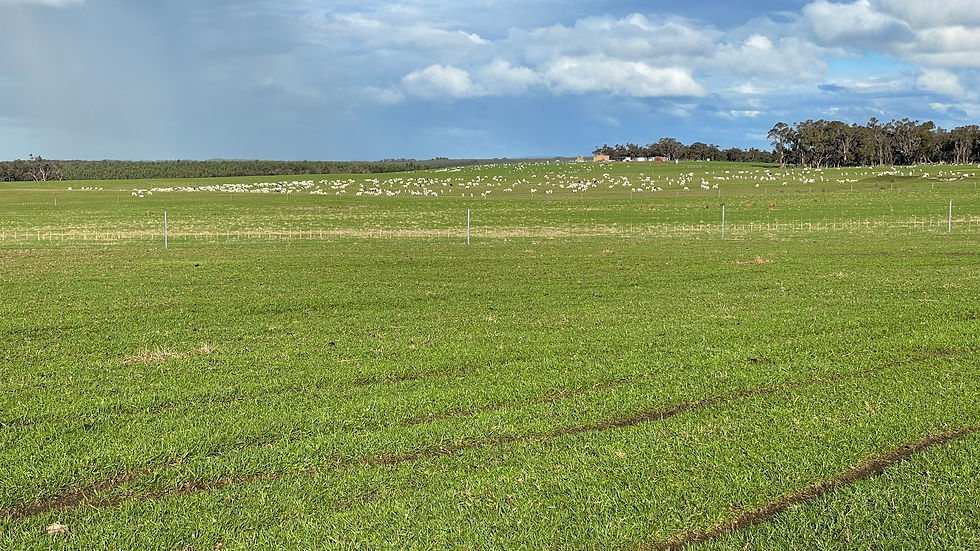Best of times in the crazy times.
- Wayne
- Jun 11, 2023
- 4 min read
Updated: Jun 12, 2023
Sorry I have been a little lax in updating you what has been happening on our farm. It seems the world has gone crazy, but as hopefully many of you know, we are living in the greatest times ever and we have the most amazing times ahead of us. Just a little more craziness, then justice, then great times.
In regards to Caluka Farms, we have been blessed with financial support from the NAB bank in March 2022 in that we could stop selling ewes for cashflow, and could keep all the ewes to build our numbers up towards our target of 30 ewes/ha (which equates to 5,500 ewes on the 185ha).
Every livestock farmer in Australia has been suffering this year by a sudden block in selling sheep to abattoirs and feedlotters. Since the end of 2022, it was getting difficult to book sheep ahead into an abattoir. Early in 2023, we managed to get three bookings in, only to see all three cancelled on us. The bigger farmers seem to be able to get some sheep in, but us small farmers were getting blocked. Our cull ewes were also too heavy, even though the abattoir they were booked into used to love our big ewes. Most of ours are 80-110kg liveweight (LW). That abattoir now only wants 60-80kg mutton. I'm pretty sure this is only temporary whilst the crazy times on earth finish playing out.
So as much as I did not want to do it, we needed to sell breeding ewes to get the cashflow since selling sheep for meat had suddenly gone to zero. We were offered between $300-$500 for drafts from our three ewe mobs (Cleanskins being the highest, but good maiden ewes also from our Woollies and Drys mob). I said no to the $500 offer as they are our best ewes, but yes to the $300-$400 offer. By the way, our Dry's mob is mostly maiden ewe lambs waiting to be joined with the rams.
One week later, the Governments in Australia announced they were going to ban livesheep export. Even though that is not where most of our wethers go to, it put a big pause over the whole sheep industry. The sale of our $300-$400 maiden ewes was cancelled. Everyone suddenly stopped buying and is waiting to see what happens. So all of a sudden, we were not able to sell anything for awhile. Fortunately we were able to sell our remaining wethers and most of our excess ram lambs and cull ewes to the saleyards, but we only received $79 average. Prices are currently even lower, and many sheep are not even getting a bid and need to be taken back to the farms. Tough times for everyone in the industry.
Now to the good news. The upside of not selling ewes is that we continue to stay on track to reaching our target of 5,500 ewes on the ground by the end of 2023. Land prices have stayed high and we are applying to extend our overdraft to see us through to the end of the year, and some shareholders purchased more shares. The end of 2023 is the beginning of when we will start selling thousands of ewes for those wanting to breed hairsheep, and we should begin achieving our target of producing ~9,000 lambs/year off the 185ha.
With the steady decline in size of meat sold in the retail outlets, for the same high price, this actually bodes well for us in that we will be turning off our lambs on the smaller side when we get to our stocking rate goal. Kg meat/ha is our goal, not kg meat/animal. Where big sheep are wanted by the market, our cull ewes will fit that niche. Where markets want large lambs, we will increasingly leave that up to the feedlotters to take lambs like ours and fatten them up longer.
Our pastures are currently in good condition despite a very dry May. More fertiliser will be applied later in the year to provide enough feed for the increasing sheep numbers. We've again achieved ~115-120% lambs marked for the first lambing of 2023, and ~3,000 ewes have been joined with the rams. Scanning of those will happen in July and lambing begins again in late September 2023. Immediately after scanning, we are beginning our intensive scanning of the eID tags (electronic identification tags in the ears) such as who scanned dry (not pregnant), single, twins, triplets etc, and we can start separating the ewes who are producing lambs twice per year.
By the end of the year, most of our ewe lambs will have been born from ewes that produced lambs twice per year. Biannually mated ewes. When we are at our target number of ewes (30/ha, or 5,500 on the 185ha farm), we will start culling many more ewes who do not get back into lamb twice per year. If they only produce lambs once per year, they will go onto the cull list. They will be excellent hair sheep for farmers wanting to get into hair or shedding sheep, however, because we can in our environment, we will be honing in on the genetics that can produce lambs twice per year, and hopefully twins twice per year.
Now for some photos. Please see the descriptions for details on what is in the photos.









Comments